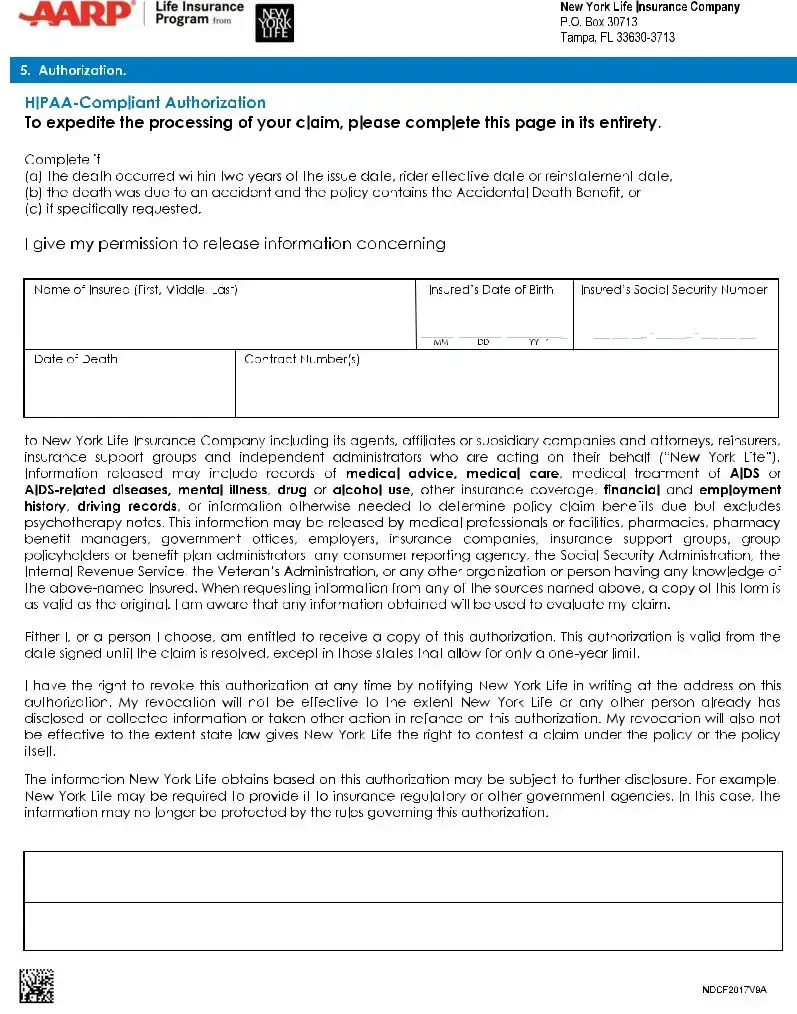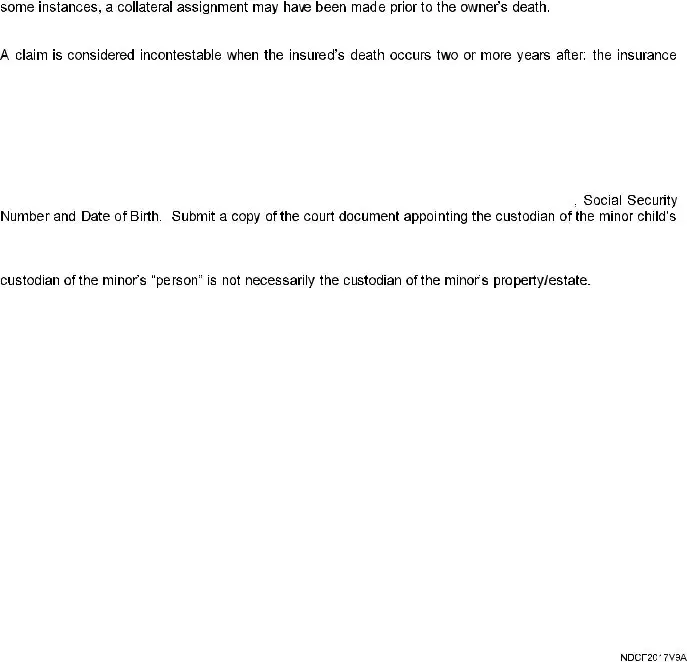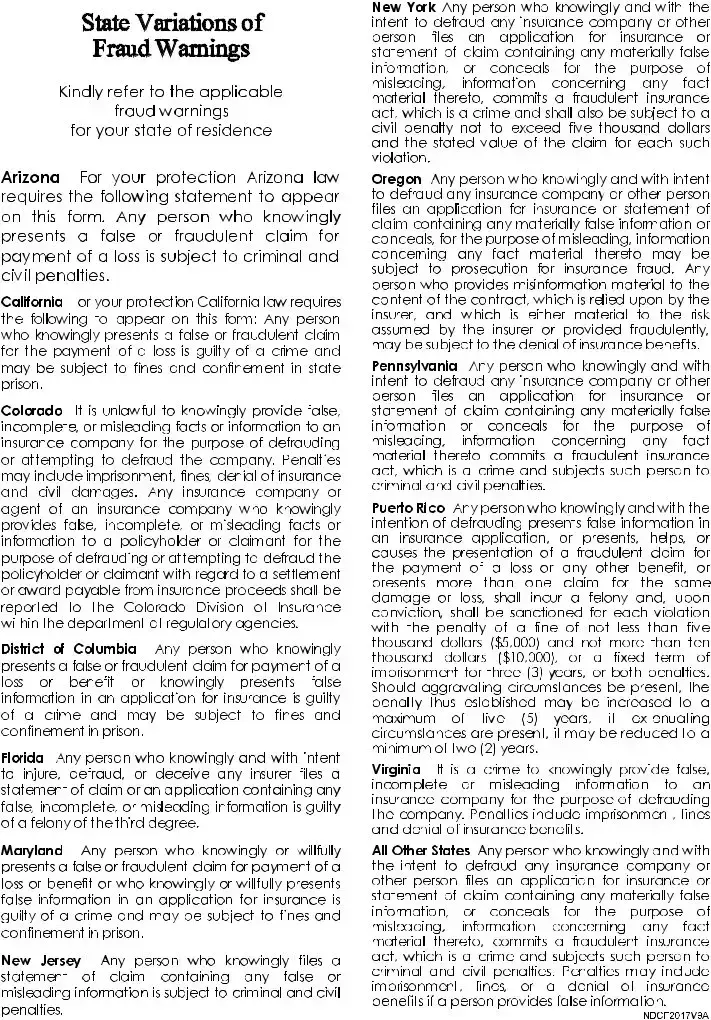
New York Life Insurance Company
AARP Operations
Claims Service
P.O. Box 30713 Tampa, FL 33630-3713 1-800-695-5165
Dear Beneficiary:
Please accept our condolences on your recent loss. We understand this is a difficult time, and hope that we can alleviate any concerns you may have about your claim.
We are providing the enclosed Claim Form complete with step-by-step instructions on how to submit your claim. Please return the completed Claim Form along with a certified death certificate and any additional requested documents, so that we can process your claim as soon as possible.*
We have provided a Frequently Asked Questions section containing information that will assist you in completing the Claim Form.
We appreciate the trust placed in us and are proud to continue that tradition in service to you. If you have any questions, please call 1-800-695-5165. Representatives are available from 8 a.m. to 6 p.m. (Eastern Time) Monday through Friday.
Sincerely,
Monique Rivera-Helms
Monique Rivera-Helms
Corporate Vice President
*New York Life reserves the right to determine whether any insurance was in force at the time of death, as well as the beneficiary to whom proceeds may be payable.
HOW TO COMPLETE YOUR CLAIM FORM:
To facilitate the processing of your claim, please send us a fully completed Claim Form from each beneficiary, one certified death certificate and other documents that we may request. For additional Claim Forms, visit our website at nylaarp.com
No original documents will be returned.
Section 1: List all the Contracts under which you are making a claim.
Section 2: Information about the deceased is necessary for purpose of identification and benefit determination.
Section 3: Beneficiary information and signature instructions:
Taxpayer Identification Number: Life insurance benefits are generally not subject to income tax. However, New York Life pays interest on the insurance proceeds from the date of death. Since the interest paid to you may be taxable, you should consult your tax advisor.
The Federal Government requires us, and all other financial institutions, to report interest we pay to you. Therefore, we are required to obtain your Social Security or other Taxpayer Identification Number, which you must certify under penalties of perjury. If you are applying for a tax number, the Federal Government requires us to withhold a portion of your interest as a deposit against the taxes that may be due.
Some persons may have been notified by the Internal Revenue Service that
report all their interest or dividends. If you have been so notified, and a backup withholding order has not been rescinded, you must check the Backup Withholding section right below your Income Tax Certification. We may contact you for more information if there are any questions about your Taxpayer Identification Number or back up withholding status, or if you are a non-resident alien or foreign entity.
Section 4: Please sign the Claim Form in the same manner as you would normally sign your checks. Your signature may be used to verify instructions you give us in the future.
Sections In order to expedite the processing of your claim, please complete the Authorization 5 and 6: and Medical Information sections if all or any portion of the insurance coverage is
less than two years old at the time of death.
Illinois Interest Statement:
If the contract was issued in Illinois, you will be paid 10% interest, from the date of death, if your claim is not paid within 31 days of receipt of the necessary proofs needed to settle the claim.
Please send your fully completed Claim Form and one certified death certificate, along with any additional requested documentation to:
Regular Mail |
Express Mail: |
New York Life Insurance /AARP Operations |
New York Life Insurance /AARP Operations |
ATTN: Claims Department |
ATTN: Claims Department |
PO Box 30713 |
5505 W. Cypress Street |
Tampa, FL 33630-3713 |
Tampa, FL 33607 |
1-800-695-5165 |
1-800-695-5165 |
FREQUENTLY ASKED QUESTIONS:
How do I obtain a certified death certificate, and how do I know the death certificate I receive is certified?
Most funeral homes will provide the family of the deceased with several certified death certificates. You may also contact the Vital Records Division in the state of the deceased for this document. Certified death certificates contain the signature of an appropriate officer of the county, city or state and will have either a raised seal or a multicolored signature seal from the county, city or state of issuance. If the manner of death is pending on the death certificate we receive, we will require an additional death certificate listing the final manner of death.
The designated beneficiary is deceased, what do we do?
Please provide a copy of the certified death certificate for the deceased beneficiary.
What is a funeral home assignment?
A funeral home assignment is a binding contract between a contract owner or beneficiary and the funeral home. This will allow us to direct payment of all, or a portion of the proceeds, to the funeral home. The funeral home assignment must be signed by the beneficiary and must be received in our office prior to the settlement of the claim. We are obligated to honor the assignment and pay the funeral home accordingly. In
What is an incontestable claim?
date; reinstatement date; or the effective date of any rider.
What is a contestable claim?
Aclaim is 





































 : the insurance date; reinstatement date; or effective date of any rider. On contestable claims, the HIPAA Compliant Authorization section must be signed.
: the insurance date; reinstatement date; or effective date of any rider. On contestable claims, the HIPAA Compliant Authorization section must be signed.
What if the beneficiary is a minor?
Please complete Section 3 of the Claim F 




































property/estate. If a legal guardian has not been established for the property/estate of the minor child, payment may be considered under the Uniform Transfers to Minors Act, (UTMA), or the Uniform Gifts to Minors Act, (UGMA) subject to state guidelines. Please contact our office for further information. Note: The
Are life insurance proceeds subject to taxation?
Any interest paid on death proceeds is subject to federal and state taxation. We will not withhold income tax from interest unless you have advised us that you are subject to backup withholding or if the taxable portion of all payments for the year is less than $200.00. Interest is paid on most claims from the date of death until the date the claim is paid. The Social Security Number or Tax Identification Number is required to report interest payments to the Internal Revenue Service.
What is IRS Tax Form 1099-INT?
Forms 1099-INT are utilized to report to the Internal Revenue Service interest payments made to an individual or entity (such as a trust or estate) during any calendar year. Forms 1099-INT are mailed to an individual or entity in January of the year following the interest payments. Form 1099-INT informs the individual or entity of the interest amount to be reported on their tax return.
What is FATCA?
The Foreign Account Tax Compliance Act, (FATCA), is a United States law designed to combat tax evasion by U.S. persons/entities. Provisions to the law include expansive withholding and information reporting rules aimed at ensuring U.S. persons and entities with financial assets outside the U.S. are paying U.S. taxes.
What if the insured was confined in a skilled nursing home for 180 consecutive days prior to his/her death?
Additional benefits may be available and their eligibility is outlined in the Contract Provisions. Contact New York Life for specific information.
Please Print Name:
Signature |
Relationship to Insured* |
Date |
X
*Authorized Representative must provide proper documentation, such as Estate representation documents.
This Page Intentionally Left Blank
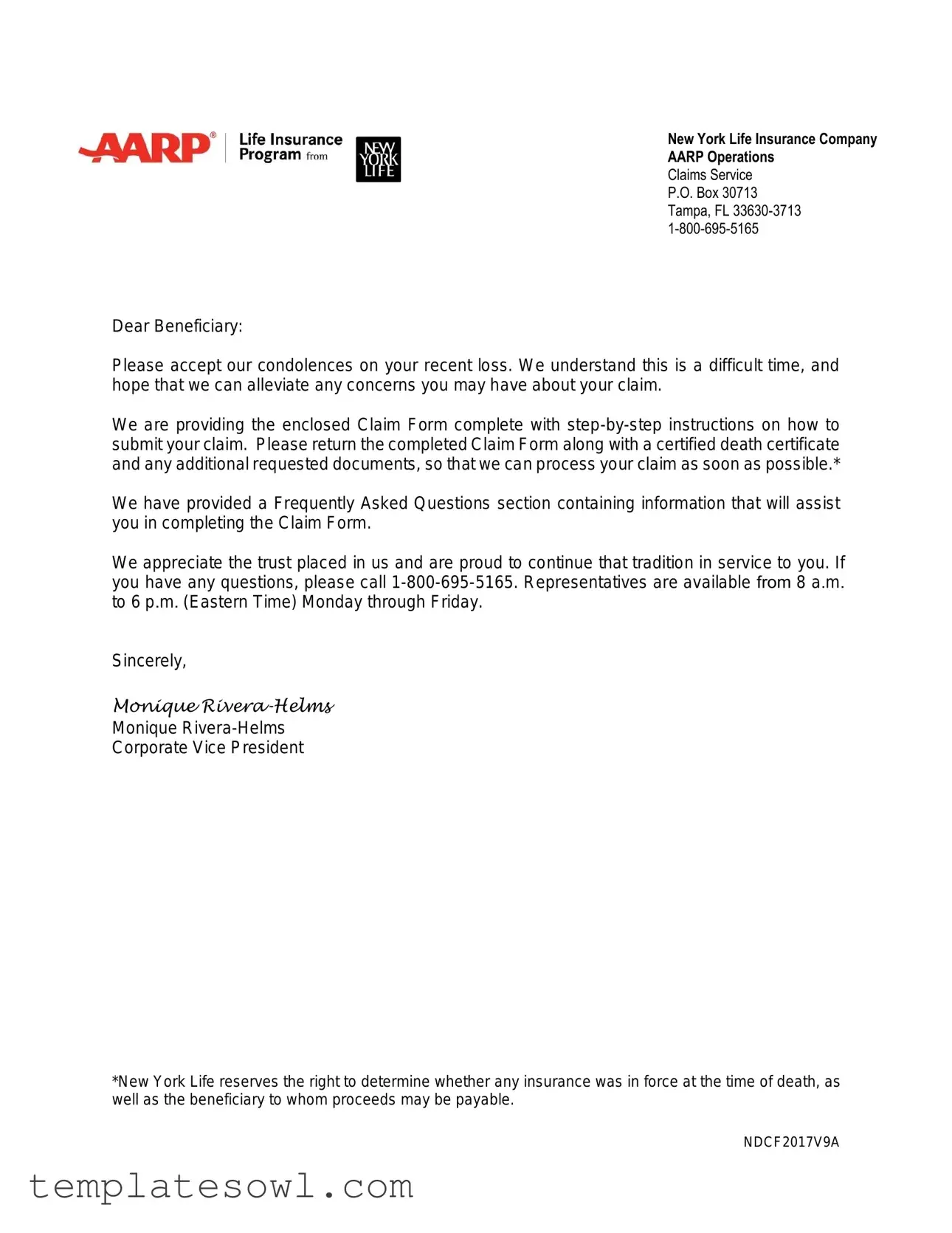

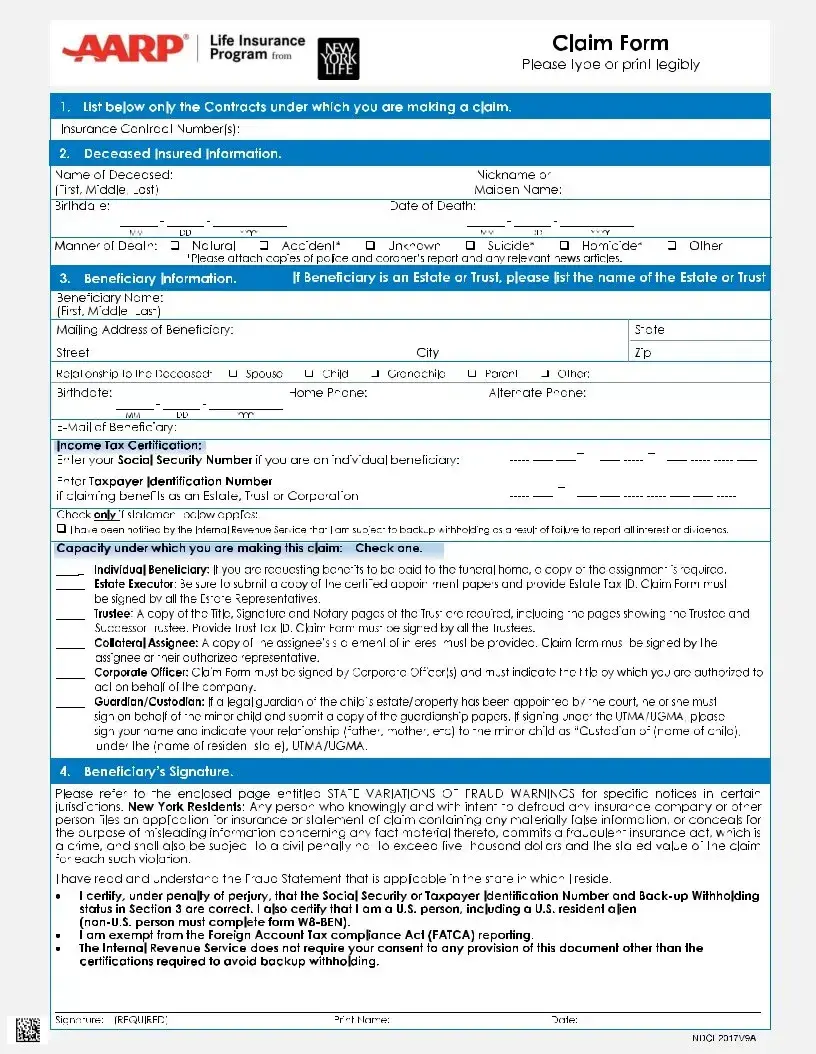
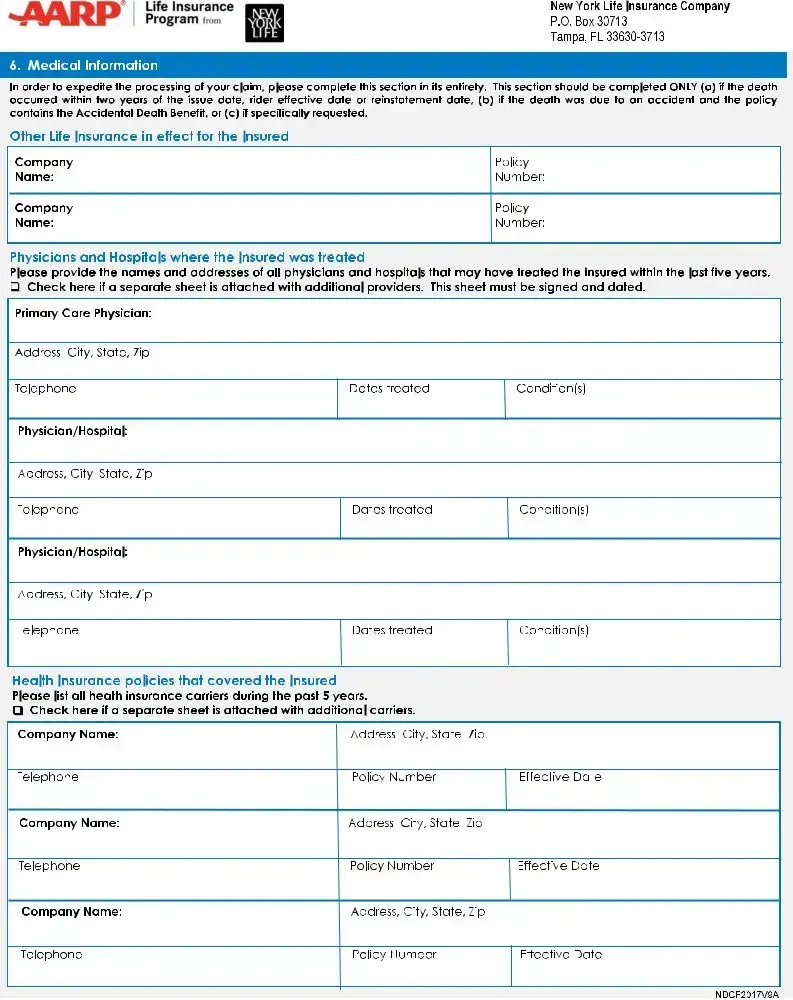






































 : the insurance date; reinstatement date; or effective date of any rider. On contestable claims, the HIPAA Compliant Authorization section must be signed.
: the insurance date; reinstatement date; or effective date of any rider. On contestable claims, the HIPAA Compliant Authorization section must be signed.





































